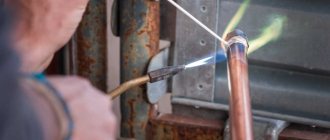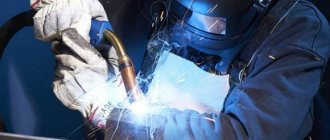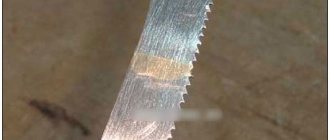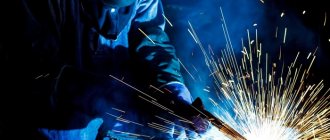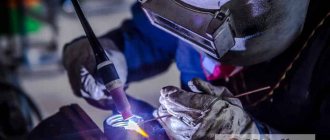Protect your eyes | 11/27/2018
Band saw tools are constantly subject to tensile stresses, causing the saw blades to break frequently. Despite the fact that tool steels are not very readily welded, welding the saw blade is considered the only way to restore the functionality of the blades. For which, of course, you will need a machine for welding band saws.
general information
At first glance, welding and soldering band saws for wood or metal does not seem such a difficult task. The work is simple and straightforward. This is true, but there are some nuances. You must take into account that the band saw experiences significant loads during operation. These loads constantly stretch and bend the saw. And if the saw copes successfully, then the welded joint may not withstand these loads. And the point here is only in the quality of work. In order for the seam to withstand all the loads, it must be as strong as the saw itself.
How to achieve a quality connection? Of course, by entrusting the welding to a special apparatus. To achieve a strong permanent seam, you can use flash butt welding technology. But at the same time use a special machine for welding band saws. Let's talk about this in more detail.
Welding Features
If part of the band saw breaks, it is necessary to prepare the blade for welding. The oxide film is carefully removed from both surfaces, since such a film interferes with reliable welding, and sometimes completely interrupts the process. After degreasing, wipe the area with a damp cloth.
The next preparatory stage is grinding the ends of the saw blade to be welded. At home, a router is used for these purposes, and if the edges of the blade are securely fastened on a bench, an ordinary grinder with a fine-grained abrasive disc will do. The edges are sharpened at an angle of 45º and then applied to each other, making sure that there is no visible gap between them.
It happens that a torn saw blade is deformed. Welding band saws for metal with a twisted blade is impossible, so you will have to first conduct a tempering, the mode of which is selected according to the steel grade. For band saws that are made of high-speed steels, the tempering mode consists of heating them to 300...400ºС, holding them at this temperature for 2...3 minutes and then slowly cooling them in still air. Band saws made of carbon alloy steels are tempered at a lower temperature - 180...250ºС.
Edge welding can only be butt welding.
Equipment used
There is a separate group of welding machines for working with band saws. That's what they're called - a machine for welding band saws. They all differ only in the degree of automation. The simplest budget models have on board manual adjustment of the welding mode and control of seam formation. And the most expensive models are capable of welding automatically without an operator.
We will tell you about the simplest machine for welding band saws on wood or metal. It is shown in the picture below. The design is simple: 1 - housing, 2 - welding transformer, 3 - clamping mechanism with electrodes, 4 - start button.
Stages of welding work
cutting
First, the saw blade must be cut to a given length. You can use different tools for cutting. We recommend guillotine shears as they give the most even cut. The cut itself should be located at the top of the teeth. Don't forget to leave about 1-2 millimeters on the cut side for settling.
To achieve an accurate cut, you can use the technique shown in the picture below. After such cutting, the ends of the saw will be smooth and fit perfectly together. And this directly affects the quality of the weld.
Stripping
After cutting, the ends of the saw need to be cleaned. This is standard preparation of metal for welding. Clean the metal from dirt and traces of corrosion. Then degrease with any solvent. For example, acetone. Then clean the edges with an abrasive material. We use sandpaper. Make sure there are no burrs on the edges. Ideally, they should be smooth and even.
Installing the saw into the clamps
Above, we could already familiarize ourselves with the components that make up a machine for welding band saws. We said that there is a clamping mechanism. This is where the saw blade needs to be installed. The clamp has a movable and a stationary part. Place one end of the blade in the movable one and the other end in the fixed one. There is free space between the clamps. You need to install the canvas so that its joints are exactly in the middle of this space. Naturally, the joint must be smooth and precise.
Welding mode selection
Next you need to select the welding mode. If you have a simple welding machine, then all parameters need to be configured manually. The welding mode is selected based on the size of the saw and its cross-section. The larger the cross-section, the greater the welding current. These are general recommendations.
Typically, the welding machine comes with instructions that describe all welding modes depending on the size of the saw blade. Also pay attention to the setting of the speed of current pulses. For budget models, it must be controlled manually, otherwise the metal will heat up too much. The recommended current supply time is 1-2 seconds. In more expensive devices, this parameter is adjusted automatically.
Welding
Welding for band saws begins with turning on the machine. The machine for welding band saws is launched depending on the model. This can be a separate button or a special handle. After starting, a welding current will be supplied to the ends of the saw, which will melt the metal in the area of the future seam. Current is supplied to the saw through the clamps. After heating the joint, the movable clamp must be moved slightly to form a weld bead. The seam is ready!
Make sure the electrode surface is clean before welding. It is not necessary to clean all the electrodes, just the part that is in contact with the saw blade is enough. If you ignore this rule, the connection will be of poor quality. Contamination will affect the circuit resistance.
Annealing
Next comes annealing. It is necessary because as a result of welding, the metal becomes too hard, which increases its fragility. Annealing helps return the canvas to its original condition. After pressing, the metal becomes plastic again, and its performance characteristics improve.
To perform annealing, you do not need to remove the blade from the clamp. Just set a different current mode. The main thing is to achieve a heating temperature of about 600 degrees. Expensive devices have a separate annealing function. But if you have a simple budget model, then you need to perform a few additional steps.
First of all, keep in mind that in addition to heating, you also need to cool the metal. And it is advisable to perform these operations one by one. Press the current supply button and hold it until the heating temperature appears on the display. Then release and let the metal cool. To ensure that the sheet cools evenly, you can periodically press the button again, preventing the metal from cooling quickly. Cooling time takes on average 5 minutes.
If your device does not have a display indicating the heating temperature, then you can focus on the color of the metal. Typically, the canvas takes on a cherry tint when the required heating temperature is reached. Do not allow the metal to become orange or yellow. Sometimes it is necessary to anneal twice.
Re-stripping
During annealing, visible sagging may form on the canvas. They need to be removed by re-cleaning. Now it is needed not for technical, but for aesthetic purposes. At the same time, you can correct the depressions between the teeth, giving them the correct geometric shape. Repeated cleaning can be done with any abrasive tool. Process the metal so that the joint is practically invisible.
Soldering
When the contact welding method is not available, high-temperature soldering is used with silver solders with a special borax-based paste flux. To secure the ends of the canvas, a simple homemade device is used. Heating is carried out by a gas burner.
Soldering is carried out according to standard methods. Flux is applied to the beveled ends of the saw. After clamping in the fixture, the joint is heated to the melting temperature of the solder placed nearby. Under the action of capillary forces, it will begin to be drawn into the joint. After solder appears along the entire connection line, heating stops. After cooling, the saw is removed and cleared of deposits.
Quality control
Do-it-yourself band saw welding is completed. But if you lack experience, you will probably have visible defects. So do visual quality control. Carefully inspect the seam and make sure there are no defects. The most common defects are displacement of the edges, release of molten metal onto the blade and lack of penetration. The edges move due to insufficient current. The release of molten metal, on the contrary, when the current is too high. And lack of penetration is formed due to low pressure or low current.
Processing of sheets after welding: annealing and cleaning
During the welding process, the joint, along with strength, also acquires fragility. One targeted blow with a heavy tool breaks the integrity of the seam.
To restore elasticity to the joint, it is necessary to anneal it.
Annealing
The implementation of such a process is carried out on the same machine equipment without disconnecting the web from the clamping mechanisms.
Annealing is performed by changing the current mode and reducing the forces on the blade.
With a gradual increase in current, the connection point is heated to a temperature of 500-550 degrees. Carrying out such a procedure involves the preliminary installation of a pyrometer that controls the increase in temperature exposure at the connecting point.
After reaching the required values, the electricity supply is stopped, after which it is necessary to wait for the canvas to cool.
When installing equipment and carrying out work in an unheated room, when the saw cools down, it is necessary to periodically turn on the current supply.
A sharp change in temperature on the surface of the canvas will lead to disruption of the technology and loss of strength characteristics. Normal cooling of the metal should take from 3 to 5 minutes.
Do not forget that some types of metal require double processing. Experienced specialists simultaneously carry out annealing during welding.
Stripping
Cleaning after welding
The main requirement for such a procedure is the maximum removal of metal deposits and the creation of a clear weld geometry.
The procedure is performed with any abrasive material or tool.
The decisive factor here is the absence of any roughness on the surface of the saw. In this regard, the surface should be cleaned not in the classical way across the canvas, but along it.
